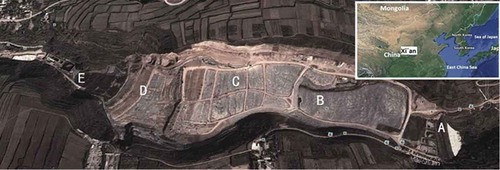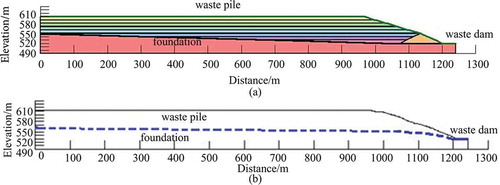ABSTRACT
With the rapid increase of city waste, landfills have become a major method to deals with municipal solid waste. Thus, the safety of landfills has become a valuable research topic. In this paper, Jiangcungou Landfill, located in Shaanxi, China, was investigated and its slope stability was analyzed. Laboratory tests were used to obtain permeability coefficients of municipal solid waste. Based on the results, the distribution of leachate and stability in the landfill was computed and analyzed. These results showed: the range of permeability coefficient was from 1.0 × 10–7 cm sec–1 to 6.0 × 10–3 cm sec–1 on basis of laboratory test and some parameters of similar landfills. Owing to the existence of intermediate cover layers in the landfill, the perched water level appeared in the landfill with heavy rain. Moreover, the waste was filled with leachate in the top layer, and the range of leachate level was from 2 m to 5 m in depth under the waste surface in other layers. The closer it gets to the surface of landfill, the higher the perched water level of leachate. It is indicated that the minimum safety factors were 1.516 and 0.958 for winter and summer, respectively. Additionally, the slope failure may occur in summer.
Implications: The research of seepage and stability in landfills may provide a less costly way to reduce accidents. Landslides often occur in the Jiangcungou Landfill because of the high leachate level. Some measures should be implemented to reduce the leachate level. This paper investigated seepage and slope stability of landfills by numerical methods. These results may provide the basis for increasing stability of landfills.
Introduction
With the improvement of the living standard, more and more people start to pay attention to their living environment. Thus, waste disposal becomes a worthwhile problem to study. Sanitary landfill is widely used to dispose the municipal solid waste (MSW) by many countries, because it can deal with most of the MSW, and because the cost of this approach is lower than other methods. This method has been widely used for a long time as a method to dispose MSW.
In recent years, research on landfill has gained significant attention. However, sliding of waste slope still occurred frequently at home and abroad. Slope instability of disposed waste not only brings great damage to people and property but also causes serious environment pollution. For example, in 1997, the leachate refilled the Dona Juana Landfill in Columbia, and the landfill failed because the leachate water level was too high. Due to the accident, nearly 1,200,000 m3 of waste were accumulated within 20 minutes (Blight, Citation2008; Koerner and Soong, Citation2000b). A landslide in the Payatas Landfill in the Philippines occurred in 2000 because of the continuous heavy rains. In the catastrophe, approximately 278 persons were killed and 100 persons were missing (Merry et al., Citation2005). In 2002, a landslide occurred on a landfill of Chongqing because of rainstorm. In this accident, approximately 400,000 m3 of waste slid down and killed 10 persons (Shen, Citation2011).
To minimize accidents, many researchers investigated the unstable circumstances of landfill. For instance, by assuming leachate water level, Koerner and Soong (Citation2000a) analyzed the relation between relative water level and minimum safety factor. Combining the mechanical properties of MSW, Plaxis (Citation2004) analyzed the stability of landfill by finite element and limiting equilibrium methods. Gharabaghi and others (Citation2008) utilized conventional limit equilibrium analysis to calculate the factors of safety for landfill stability. Zheng (Citation2012) presented the three-dimensional (3D) version of the Morgenstein–Price (M-P) method to study the stability of landfill. By using numerical computation and analysis, Xu and others (Citation2013) gave the key position of leachate leaks and proposed measures to reduce the leakage volume and to improve the stability of landfill. To analyze the reason for instability in landfill, domestic and foreign researchers studied and analyzed the following influence factors.
The mechanical properties of MSW are important to the stability of a landfill. One of the most important properties is shear strength because plastic objects interact with other materials, and the shear strength of MSW is determined by the bonding strengths of these materials. According to the analysis of researchers (Zekkos et al., Citation2010), the unit weight of MSW may sometimes affect shear strength. With the same composition of waste, by reducing the unit weight by 2 kN m−3, the shear strength declines by 20%. Therefore, the unit weight of MSW is another mechanical parameter that affects landfill stability.
The permeability coefficient of landfill is the key index to determine the quantity of leachate, and this index is closely related to the depth and unit weight of the waste. Many researchers tested the permeability coefficient by field test and laboratory analysis. Through laboratory test, Zhang and others (Citation2007) studied the soil–water characteristic curves, derived the function of permeability, and calculated the landfill stability. Reddy and others (Citation2009) pointed out that the permeability coefficient of waste is mainly affected by void ratio. Generally, the permeability coefficient decreases as the effective stress and void ratio decrease. Therefore, permeability decreases with the increase in dry density. Zhang and others (Citation2013) measured the permeability coefficient of landfill in southern China through field investigation and laboratory tests and analyzed the saturated–unsaturated seepage to study its stability. lists some measurements of permeability coefficient of the landfill.
Table 1. Permeability coefficients of MSW in landfills
The first step in the current paper was to collect samples based on similar studies. The unit weights and permeability coefficients of Jiangcungou Landfill were tested by laboratory test. The mechanical characteristics and permeability coefficients of every unit of the landfill were obtained on basis of laboratory test and some parameters of similar landfills. Finally, the numerical method was used to analyze the seepage and stability of the landfill. To obtain a result close to the real condition, the model was separated into blocks and layers in considerable details. This approach could simulate the technology on zones and units of landfill.
Profile of Jiangcungou Landfill
Jiangcungou Landfill is a valley landfill located in Xian, China. The landfill is approximately 16.5 km from the city center and covers approximately 687,333 m2. The total capacity is 49 million m3, the design maximum altitude is 120 m, and the total length is 1.5 km. The minimum width is 30 m at the base of the landfill, and the maximum width is 500 m at the apex of the landfill. The average altitude is 65 m, and the highest is at 80 m. The maximum height increased up to 70 m by 2012. The landfill is the only one in Xi’an and accommodates the disposal of 3300 tons of waste per day with a designed working life of 50 years. The composition of the waste is mainly plastic, paper, glass, fabric, dregs, and so on. shows the location and the satellite imagery of the landfill. In this figure, A represents the upstream dam state, B and C have completed the construction, D is under construction, and E is the downstream dam area.
In recent years, a lot of problems appeared in the landfill. In October 2011, after the flood season, the leachate did not get out of the landfill in a timely manner. Thus, landslide and collapse occurred in the landfill, and the waste of landslide extended to about 20,000 m3. The leachate production was nearly 1200 t day−1, and the excretion of leachate was nearly 300 t day−1 at the bottom of the landfill. Therefore, studying the distribution of leachate in landfills is important.
Test and parameters
Unit weight
Zhan and others (Citation2008) investigated the relationship between shear strength and age of the landfill in Suzhou. Bray and others (Citation2009) found the strength envelope of MSW via shear strength analysis and found that the strength envelope can be applied to most of the landfill. According to some data on landfill recommended by Zekkos and others (Citation2006), the average unit weight of MSW is 12 kN m−3 at a depth of about 30 m. shows the relationship between unit weight of MSW and depth. The growth rate of unit weight decreases with the increase in depth. Combining the figures with that of landfills in China, Tu and Qian (Citation2008) improved these three curves in . They provided the unit weight of typical compacted soils as 10–14 kN m−3. Through field sampling, the unit weight of top waste was measured. The average unit weight is 8.0, 8.3, and 8.4 kN m−3 at 10, 30, and 50 cm, respectively. By comparing the top sample and reported curves in , other data of this landfill were achieved. demonstrates the relationship between the unit weight and depth in Jiangcungou Landfill.
Figure 2. Comparison of MSW unit weights between Jiangcungou Landfill and Zekkos and others (Citation2006).
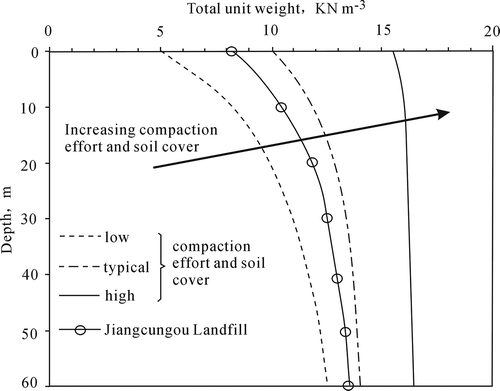
Permeability coefficients
To obtain the permeability coefficients close to the actual situation, the top wastes in the field were conducted and the permeability coefficients of the waste were tested. Test samples were taken in six groups with 18 samples, including four groups in upstream and downstream of region C and two groups in region D in . According to Penmethsa (Citation2007), the permeability coefficients were tested by constant head method in the laboratory. The diameter of the sample is 80 mm, and the height of the sample is 140 mm. The permeability coefficients can be calculated by eq 1.
k = QL/hAt (1)
where k represents the permeability coefficient of sample (m sec−1); Q is the amount of flow during the time (m3 sec−1); L is the height of the sample (m); h is the constant head (m); A is the cross-sectional area of the sample (m2); and t is the time (sec). shows the testing equipment.
At the beginning of the test, the water was retained through the sample for a period of time to saturate the sample. The sample could not be tested until bubbles were produced. To avoid water flows from the optimum corridor, the flow of water through the sample was measured by bottom-up method. At first, the saturated permeability coefficient fluctuated. After a period of time, the situation stabilized. Finally, the sample could be tested. According to a large number of permeability coefficients at home and abroad, shows the values of saturated permeability coefficient (Ministry of Housing and Urban-Rural Development of the People’s Republic of China, Citation2012). The curves can be used to design a new landfill or to substitute for missing test data. By comparing the top sample and reported curves in , other data of this landfill were achieved. It turned out that the permeability coefficient decreased along with depth. With analyzing the reason, it showed that the older the landfill, the greater the settlement, the higher the compactness of waste, and the smaller the permeability coefficient.
Figure 4. Comparison of MSW saturated permeability coefficients between Jiangcungou Landfill and technical code (Ministry of Housing and Urban-Rural Development of the People’s Republic of China, Citation2012).
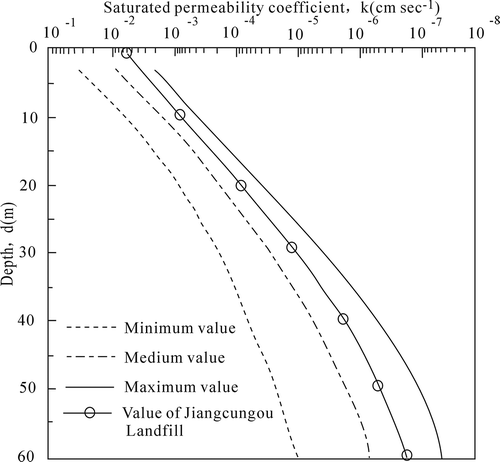
Seepage analysis
Model and parameters
The landfill has saturated–unsaturated seepage and complies with the basic theory of seepage in soils. SEEP/W is a module of the finite element software GEO-STUDIO, which was mainly used to calculate seepage flow in rock and soil. The module can be combined well with stable module to calculate the stability. Thus, the seepage of the landfill was analyzed by SEEP/W. The theoretical formulas of the software and the permeability test are based on Darcy’s law (Gray and Miller, Citation2011).
To create a landfill model, considering the technology of sanitation fill in Jiangcungou Landfill, the waste pile is divided into eight layers, which are (from bottom to top) first layer, second layer, …, and eighth layer. The average thickness of each layer is nearly 10 m, and first layer is close to waste dam and the top layer is eighth layer. According to the data of and , seepage analysis was conducted by SEEP/W software. The 2D model of typical cross-section in the landfill is shown in . The impervious foundation was 40 m away from the landfill bottom. The upstream water level was 552 m, the downstream level was 530 m, and the month rainfall depth was 159.9 mm in summer of Xi’an. Boundary conditions were determined in the model according to the above information. The siltation phenomenon in the drain appeared because the landfill was located at the loess covering area. The rainfall formed into a small pond in a certain area in the upper stream. The pond was one of the sources of the leachate and was unfavorable to the stability of the landfill. The flux boundary conditions were considered at the top of the landfill because the leachate mainly came from the rainfall. The drainage system can be simulated by setting the drainage boundaries, and the location was 50 m from the slope in each layer. The parameters of seepage shown in were selected to calculate the seepage of the landfill.
Results and analysis
There were two scenarios during seepage calculation. Scenario 1 was the seepage of landfill in winter, whereas the other scenario was in summer. Winter includes December, January, and February, and summer includes June, July, and August. The landfill has low rainfall in winter and high rainfall in summer. The seepages in winter and summer were calculated using seepage model (regardless of moisture evaporation). shows the leachate level under winter precipitation. The blue line represents the location of the leachate level. The calculated leachate level was 552 m because precipitation in winter had little effect on landfill leachate.
The distribution of the landfill leachate was calculated based on precipitation intensity in summer (). The results showed several layers of leachate in the waste pile. The blue lines represent the location of perched water level. Within the new landfill layer, the level was high. However, within the older landfill layer, the perched water level was relatively low. The waste in the eighth layer was filled with leachate. The leachate level in the seventh layer reached up to 2 m in depth under the waste surface. The perched water level of the intermediate cover layer decreased as the waste deepens. At the base of the landfill layer, the leachate level reached up to 5 m in depth. During geological prospecting, the leachate emerged in multilayer distribution due to the influence of filling methods and intermediate cover layers. There were several layers of waste, and almost there were several layers of leachate in waste pile. Overall, within the new landfill layer, the leachate level reached up to 2 m in depth under the waste surface. The perched water level was relatively low within the older landfill layer. Therefore, the leachate level exhibited heterogeneity within these layers. The comparison analysis showed that numerical results were in good accordance with geological prospecting results. shows the distribution of leachate in the middle of landfill. Given that the drain was equipped in each waste layer of the downstream slope, the leachate did not flow out from the slope surface (). The phenomenon of perched water appeared in summer, which indicated that abundant rainfall was one of the reasons causing the perched water level.
Stability analysis
Model and parameters
M-P method is the limit equilibrium slice method. The method has good convergence and rigorous calculation because the method satisfied both force and moment equilibrium conditions. Limit equilibrium methods were often recognized and used in the stability analysis of landsides these methods were more reliable than others, and these methods observed the sliding surface and sliding surface above the soil as a rigid body. The interaction between the force and moment of static balance was determined, and the factor of safety was calculated.
Many researchers conducted numerous studies on landfill because the stability of landfill will directly affect the safety of people and property. The traditional methods of stability analysis of landfill aimed to find the most dangerous slip surface and calculate the relative minimal safety factor. In general, three different methods were used to calculate the minimal safety factor, namely, finite element method, limit analysis method, and limit equilibrium method. These methods used to determine the most dangerous slip surface include Mohr–Coulomb criterion (Greco, Citation1996), genetic algorithm (Gao, Citation2014; Manouchehrian et al., Citation2014), and simulated annealing (Chen, Citation2003). Zhu and others (Citation2001) created a program to calculate the factor of safety by using the M-P method. SLOPE/W is a module of the finite element software GEO-STUDIO, which mainly analyzes almost all the problems of stability in the civil, mining, and hydraulic rock engineering. In this paper, the stability of landfill was calculated by SLOPE/W software. The most dangerous slip surface and the minimal safety factor were found. The model of stability was similar to the model of seepage. shows the values of physical and mechanical properties in the landfill according to tests and the corresponding investigation.
Table 2. Statistical values of physical and mechanical properties in the landfill
Results and analysis
M-P method was selected to calculate stability using the software. During stability analysis, two scenarios were designed. Scenario 3 simulated the stability of the landfill in summer, and scenario 4 simulated the stability in winter. First, considering the condition of landfill stability in winter and combining it with the results of scenario 1, shows the results of the slope stability calculation. The most dangerous failure surface appeared in the slope of the waste dam, and the minimal safety factor was 1.516. The landfill stability in summer was calculated. Considering the leachate level in each MSW, shows the results of slope stability in summer. The most dangerous failure surface also appeared in the slope of the waste dam, and the minimal safety factor was 0.958.
Figure 7. (a) Stability analysis of landfill in scenario 3. (b) Stability analysis of landfill in scenario 4.
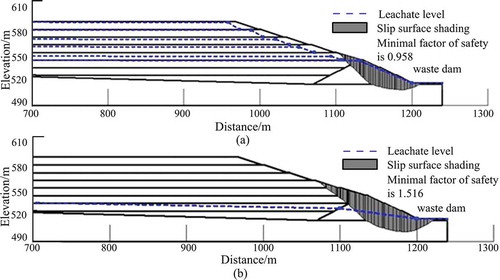
On the basis of the recommendation of the technical code for geotechnical engineering of MSW sanitary landfill (Ministry of Housing and Urban-Rural Development of the People’s Republic of China, Citation2012), the safety coefficient criterion in normal running was 1.35 because the height of Jiangcungou Landfill was more than 60 m and was designated to be at the first level. The minimal safety factor in scenario 3 was larger than 1.35, indicating that the slope of landfill was safe. With less rainfall during the winter, leachate mainly came from waste degradation and groundwater. Therefore, the pore water pressure was smaller and did not destroy the stability of landfill. However, the value in scenario 4 was smaller than 1.35, indicating the instability of the slope of the landfill. In summer, because rainfall was greater and the permeability coefficient of landfill was larger, a lot of water seeped into the landfill could not be discharged in time. Thus, the pore water pressure of landfill and garbage density increased significantly, resulting in instability and sliding failure of the landfill slope.
Conclusions
The permeability coefficients of MSW were obtained on basis of laboratory test and some relative literatures. When using numerical method to simulate landfill, the waste was divided into several layers, and loess soil was used to isolate the waste of each layer. Two scenarios were simulated in our model, in which the seepage and stability of landfill were analyzed. The results showed that (1) the range of permeability coefficient was from 1.0 × 10−7 cm sec−1 to 6.0 × 10−3 cm sec−1. Furthermore, the permeability coefficient increased along with the depth of waste. (2) The perched water level appeared in summer. Moreover, the waste was filled with leachate in the top layer, and the leachate level reached up to 2–5 m in depth under the waste surface in other layers. Compared with geological prospecting, the results of numerical method have the same distribution of the water level. (3) According to the results of stability analysis, the minimal safety factors were 1.516 and 0.958 for winter and summer, respectively. The unstable slope can occur in summer. (4) Rainfall was one of important factors affecting slope stability of landfill. The penetration of rain into waste increased water content, increased its unit weight, decreased the strength of the body of waste, and increased the pore water pressure, thus leading to instability and sliding failure of the landfill slope. (5) In order to improve the stability of landfill, effective measures should be taken which are garbage dam reinforcement and reduce leachate. Based on the distribution rule of leachate in landfill, some measures of precipitation should be taken.
Funding
This study was financially supported by the program 2013KCT-15 for Shaanxi Provincial Key Innovative Research Team; the National Natural Science Foundation of China (51409206 and 51409208); the research foundation of State Key Laboratory Base of Eco-hydraulic in Arid Area (2013ZZKT–3); the special research plan project of Education Department of Shaanxi Province (14JK1514); the special funds for the natural science foundation of Shaanxi province (2016JM5057); and the National Science Foundation for Post-doctoral Scientists of China (2014M562524XB).
Additional information
Funding
Notes on contributors
Rong Yang
Rong Yang, Zengguang Xu, Junrui Chai, Yuan Qin, and Yanlong Li are researchers of hydraulic structure at State Key Laboratory Base of Eco-hydraulic Engineering in Arid Area and Xi´an University of Technology.
Zengguang Xu
Rong Yang, Zengguang Xu, Junrui Chai, Yuan Qin, and Yanlong Li are researchers of hydraulic structure at State Key Laboratory Base of Eco-hydraulic Engineering in Arid Area and Xi´an University of Technology.
Junrui Chai
Junrui Chai also is a researcher at China Three Gorges University.
Yuan Qin
Rong Yang, Zengguang Xu, Junrui Chai, Yuan Qin, and Yanlong Li are researchers of hydraulic structure at State Key Laboratory Base of Eco-hydraulic Engineering in Arid Area and Xi´an University of Technology.
Yanlong Li
Rong Yang, Zengguang Xu, Junrui Chai, Yuan Qin, and Yanlong Li are researchers of hydraulic structure at State Key Laboratory Base of Eco-hydraulic Engineering in Arid Area and Xi´an University of Technology.
References
- Blight, G. 2008. Slope failures in municipal solid waste dumps and landfills: A review. Waste Manage. Res. 26:448–463. doi:10.1177/0734242X07087975
- Bray, J.D., D. Zekkos, E. Kavazanjian Jr., G.A. Athanasopoulos, and M.F. Riemer. 2009. Shear strength of municipal solid waste. J. Geotech. Geoenviron. Eng. 135:709–722. doi:10.1061/(ASCE)GT.1943-5606.0000063
- Chen, Y.M. 2003. Location of critical failure surface and some further studies on slope stability analysis. Comput. Geotech. 30:255−267.
- Durmusoglu, E., I.M. Sanchez, and M.Y. Corapcioglu. 2006. Permeability and compression characteristics of municipal solid waste samples. Environ. Geol. 50:773–786. doi:10.1007/s00254-006-0249-6
- Gao, W. 2014. Forecasting of landslide disasters based on bionics algorithm, Part 1: Critical slip surface searching. Comput. Geotech. 61:370–377. doi:10.1016/j.compgeo.2014.06.007
- Gharabaghi, B., M.K. Singh, C. Inkratas, I.R. Fleming, and E. McBean. 2008. Comparison of slope stability in two Brazilian municipal landfills. Waste Manage. 28:1509–1517. doi:10.1016/j.wasman.2007.07.006
- Gray, W.G., and C.T. Miller. 2011. On the algebraic and differential forms of Darcy’s equation. J. Porous Media 14:33–50. doi:10.1615/JPorMedia.v14.i1
- Greco, V.R. 1996. Efficient Monte Carlo technique for locating critical slip surface. J. Geotech. Eng. 122:517–525. doi:10.1061/(ASCE)0733-9410(1996)122:7(517)
- Hossain, M.S., K.K. Penmethsa, and L. Hoyos. 2009. Permeability of municipal solid waste in bioreactor landfill with degradation. Geotech. Geol. Eng. 27:43–51. doi:10.1007/s10706-008-9210-7
- Jain, P., J. Powell, T.G. Townsend, and D.R. Reinhart. 2006. Estimating the hydraulic conductivity of landfilled municipal solid waste using the borehole permeameter test. J. Environ. Eng. 132:645–652. doi:10.1061/(ASCE)0733-9372(2006)132:6(645)
- Jang, Y.S., Y.W. Kim, and S.I. Lee. 2002. Hydraulic properties and leachate level analysis of Kimpo metropolitan landfill, Korea. Waste Manage. 22:261–267. doi:10.1016/S0956-053X(01)00019-8
- Koerner, R.G., and W.A. Eith. 2005. Drainage capability of fully degraded MSW with respect to various leachate collection and removal systems. Geotech. Sp. 130:4233–4237. doi:10.1061/40782(161)46
- Koerner, R.M., and T.Y. Soong. 2000a. Leachate in landfills: The stability issues. Geotextiles Geomembr. 18:293–309. doi:10.1016/S0266-1144(99)00034-5
- Koerner, R.M., and T.Y. Soong. 2000b. Stability assessment of ten large landfill failures. In: Advances in Transportation and Geoenvironmental Systems Using Geosynthetics, GeoDenver 2000 Congress, August 5–8, 1–38. Geotechnical Special Publication: Denver, Colorado.
- Manouchehrian, A., J. Gholamnejad, and M. Sharifzadeh. 2014. Development of a model for analysis of slope stability for circular mode failure using genetic algorithm. Environ. Earth Sci. 71:1267–1277. doi:10.1007/s12665-013-2531-8
- Merry, S.M., E. Kavazanjian, and W.U. Fritz. 2005. Reconnaissance of the July 10, 2000, Payatas landfill failure. J. Perform. Constr. Fac. 19:100–107. doi:10.1061/(ASCE)0887-3828(2005)19:2(100)
- Ministry of Housing and Urban-Rural Development of the People’s Republic of China 2012. Technical code for geotechnical engineering of municipal solid waste sanitary landfill. CJJ176-2012, Beijing, China Construction Industry Press.
- Penmethsa, K.K. 2007. Permeability of municipal solid waste in bioreactor landfill with degradation. M.S. thesis, the University of Texas at Arlington, Arlington, Texas.
- Plaxis, B.V. 2004. PLAXIS 2D Version 8.2—Finite Element Code for Soil and Rock Analysis. Delft, The Netherlands: AA Balkema.
- Reddy, K.R., H. Hettiarachchi, N. Parakalla, J. Gangathulasi, J. Bogner, and T. Lagier. 2009. Hydraulic conductivity of MSW in landfills. J. Environ. Eng. 135:677–683. doi:10.1061/(ASCE)EE.1943-7870.0000031
- Shen, L. 2011. Liquid depth study and stability analysis of municipal solid waste landfill. M.S. thesis, Zhejiang University, Zhejiang, China.
- Stoltz, G., Gourc, J.P., and L. Oxarango. 2010. Liquid and gas permeabilities of unsaturated municipal solid waste under compression. J. Contam. Hydrol. 118:27–42. doi:10.1016/j.jconhyd.2010.07.008
- Tu, F., and X.D. Qian. 2008. Unit weight, water content and specific gravity of municipal solid waste in China and United States [in Chinese]. Chin. J. Rock Mech. Eng. 27:3075–3081.
- Xu, Q., J. Powell, T. Tolaymat, and T. Townsend. 2013. Seepage control strategies at bioreactor landfills. J. Hazard Toxic Radioact Waste 17:342–350. doi:10.1061/(ASCE)HZ.2153-5515.0000185
- Zekkos, D., G.A. Athanasopoulos, J.D. Bray, Jr. E. Kavazanjian, N. Matasovic, E.M. Rathje, M.F. Riemer, and K.H. Stokoe. 2010. Large-scale direct shear testing of municipal solid waste. Waste Manage. 30:1544–1555. doi:10.1016/j.wasman.2010.01.024
- Zekkos, D., J.D. Bray, E. Kavazanjian Jr., N. Matasovic, E.M. Rathje, M.F. Riemer, and K.H. Stokoe. 2006. Unit weight of municipal solid waste. J. Geotech. Geoenvironm. Eng. 132:1250–1261. doi:10.1061/(ASCE)1090-0241(2006)132:10(1250)
- Zhan, L.T., Y.M. Chen, and W.A. Ling. 2008. Shear strength characterization of municipal solid waste at the Suzhou landfill, China. Eng. Geol. 97:97–111. doi:10.1016/j.enggeo.2007.11.006
- Zhang, W., G. Zhang, and Y. Chen. 2013. Analyses on a high leachate mound in a landfill of municipal solid waste in China. Environ. Earth Sci. 70:1–6. doi:10.1007/s12665-013-2262-x
- Zhang, W.J., L.T. Zhan, Y.M. Chen, and H.Y. Wei. 2007. Unsaturated-saturated seepage analysis of municipal solid wastes [in Chinese]. Chin. J. Rock Mech. Eng. 26:87–93. doi:10.1002/(ISSN)1099-114X
- Zheng, H. 2012. A three dimensional rigorous method for stability analysis of landslides. Eng. Geol. 145:30–40. doi:10.1016/j.enggeo.2012.06.010
- Zhu, D.Y., C.F. Lee, Q.H. Qian, Z.S. Zou, and F. Sun. 2001. A new procedure for computing the factor of safety using the Morgenstern-Price method. Can. Geotech. J. 38:882–888. doi:10.1139/cgj-38-4-882

